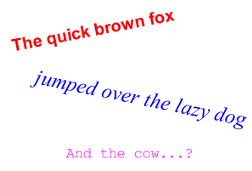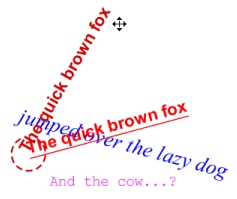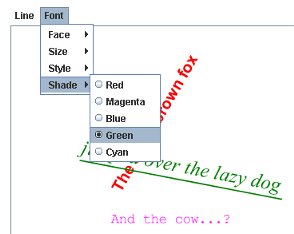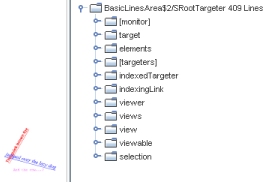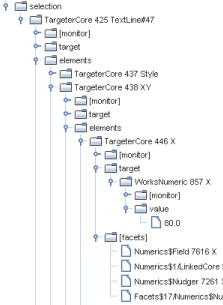 |
: Core concepts |
|
This page uses the spike applet to introduce the core concepts underlying the Superficial approach to designing and coding GUI applications. Communicating with an application - the surfaceWhat do you see when you look at the spike applet? |
||||||||||||||||||||||||
|
|
||||||||||||||||||||||||
|
You may answer that you see an applet or application, or more specifically the user interface to an application. However 'user interface' can refer to anything from a functional and aesthetic design to a particular arrangement of platform widgets. Superficial gives a more definite answer to this question:
The metaphor of surface leaves open the exact means by which a surface manages interaction between user and application, but it is easy to decide whether an application has a surface. A GUI is evidently a surface, but so is a command-line interface or even a teletype. Defining a GUI surface - facetsHow does the surface metaphor help with the practicalities of developing GUI applications? Superficial views a GUI surface as composed primarily not of its low-level widgets, but of facets that expose elements within the application. Each facet creates and manages a a group (usually) of widgets, updating their state as required to match the application element the facet exposes, and relaying input from the widgets to the application. By mediating between the GUI widgets and the application, facets make possible the key Superficial mechanism of retargeting. They also greatly reduce the number of GUI elements that need to be specified by application code. Even the simple GUI surface of the spike applet comprises nearly 140 Swing components, but these are built and managed by only around 50 facets. For instance:
The fact that facets usually manage more than one widget is a major benefit of the Superficial approach - developing a GUI is much easier if you don't have to specify each and every button, label and menu item. Behind the facets - targetsDeveloping a GUI surface with Superficial is easier in another way. Superficial defines each facet as exposing a target in the application. Targets may represent a simple data value, an action, a complete content structure, or even an element of the surface itself such as a viewer or window. The retargeting mechanism described below transparently connects facets to targets both during construction of the GUI and in response to events such as change in selection Each target in the application may be exposed by any number of facets in the surface. This means that many fewer targets are required than facets, while each facet may bind several widgets to the data represented by its target. In the spike applet
and spike application the ratios
of targets, facets and widgets are as shown below:
Manipulating content - the viewer facet and its targetsTo see how Superficial makes it much easier to define the interactions that make for a rich, responsive GUI, let's look at how the spike applet responds to user interaction with its viewer.
Superficial regards the viewer as being a facet that exposes a viewable target acting as a frame for application content, here an array of three text line objects; it also has a view target defining graphical avatars for the content. When the spike applet opens, none of the text line avatars is selected and most of the tools and menu items are disabled. Click on the avatar for a text line and a bar appears beneath it.
The avatar now depicts a selection target within the viewable target of the whole viewer. At the same time the tools panel and menu items respond by becoming enabled and exposing the values for the same selection target. Drag the selected text line to a new position,
and the Position facets in the tools panel are updated to match the new values. Drag the far end of the text line avatar to change its angle,
and the tool panel switches to the Angle tools, which are updated with the angle of the selected text line. As you change the selection target by clicking on another avatar or a Line iteration button, the tool panel and menu items are updated to match the newly selected text line. And if you change the properties of a text line using the tools panel or menus, its avatar in the viewer is updated to match.
This responsive behaviour is intuitive in user terms, but far from straightforward to code:
To put the problem in general terms, a GUI application has to ensure that it maintains view consistency at all times. Coding a GUI using conventional methods that meets this requirement can be a struggle; Superficial's concepts of surface, facet and target make possible the retargeting mechanism that makes it almost a pleasure. Oh, and it's a reasonable guess that the cow jumped over the moon. Retargeting - the key Superficial mechanismSuperficial maintains view consistency (as demonstrated in the spike applet and spike application) by treating the complete GUI surface as an integrated view of the application and its content. Refreshing this view to match the state of the application is achieved by retargeting. The facets that create and manage GUI widgets are connected to their targets in the application via a targeter tree created by the surface (and visible in the debug pane). After any significant application event all facets are retargeted via the targeter tree on appropriate targets, thus synchronising all widgets with the latest application state. Each facet uses the event handling of the GUI toolkit to listen for input on its widget(s) and interpret this input in relation to its current target. Application events that trigger a retargeting include the initial construction of the GUI surface, and any action by a facet on its target in response to GUI events. Retargeting is largely transparent to client code, enabling you the developer to let Superficial take care of the two major issues of GUI development: binding widgets to data and listening on events.
Given the update speeds of modern GUI toolkits, retargeting has minimal impact on the latency of an application surface: in the spike applet a full retargeting takes place every time you pause a drag or slider movement. Construction of the targeter tree is handled transparently by Superficial. Each contenter in a Superficial application need only define target and facet trees for its content, and its containing surface constructs a suitable targeter tree to connect them. Defining the surface - contentersThe transparency to client code of retargeting makes it possible to encapsulate the definition of surfaces and thus of complete applications. Take a look at the code in the code viewer applet, and you will find that surface elements are always defined by contenters that wrap the application content. A contenter defines
Simple applications such as those in the tutorial can be constructed using specialised contenters, while even a multi-viewer, multi-content type application such as the spike application is surprisingly easy to define. Retargeting in actionYou can view retargeting in the spike applet and code viewer using two different debug options. Toggle the Graph checkbox below the spike applet
In the left-hand pane you can still interact with the viewable content, while in the right-hand pane you can monitor the state of the targeter tree. Expand the bottom, 'selection' node of the targeter tree far enough,
and for each property of the currently selected text line you will find
Change or move the text line and the targeter tree adjusts to match. The other debug option allows you to watch the retargeting sequence that updates the targeter tree and the facets attached to it. Open the Java console for your browser and toggle the Trace checkbox below the spike applet. The applet reopens and you can watch the targeter tree being created, then the retargeting that takes place after each input to the surface.
The power of Superficial - separation of concernsBecause a Superficial surface is defined purely in terms of facets, targets and the targeter tree that mediates between them, interactions between application elements are very clearly defined.
This strong separation of concerns ensures that Superficial applications are inherently easy to develop, debug and maintain.
© 2007 David M Wright |
||||||||||||||||||||||||

 ,
size
,
size 
 ;
while in the tool panel others expose the same values using
a radio-button panel
;
while in the tool panel others expose the same values using
a radio-button panel  ,
,
 combined with indexing buttons
combined with indexing buttons 
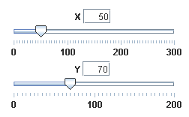 ,
while another exposes the same values using a button panel
,
while another exposes the same values using a button panel
 that has its counterpart in Line menu items
that has its counterpart in Line menu items
